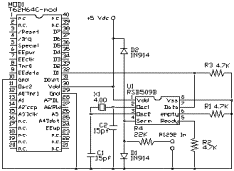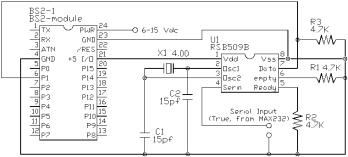Serial
Buffer IC
(Part
Number: RSB509B)
(click
here for PDF data sheet)

Overview
Protean Logic Inc.'s RSB509B is an easy to use, low cost IC that buffers RS232 serial data for a host microprocessor. The RSB509B stores up to 32 bytes of serial data received on the input pin and retransmits data to the host through the interface pin. The RSB509B frees the host microprocessor from serial data timing concerns. The real time considerations of RS232 interrupt handling are thus eliminated or reduced. Processors that emulate RS232 hardware via software, like the FBasic TICkit or the PARALLAX Basic STAMP, can perform other tasks while the RSB509B buffers serial data. The processor can retrieve the stored data when it has the time to spare by pulsing the interface pin. When using a TICkit or a STAMP as the host processor, the user program simply outputs a high on the interface pin immediately before the rs_receive or serin line.
Connecting the RSB509B is easy. Only a few pull down resistors and a crystal or resonator is required. The RSB509B only requires one connection line to the host processor.
Features
∑ Small 8-pin plastic DIP package.
∑ Requires 4MHz clock source (crystal or resonator); pull down resistors for data, empty, and ready outputs.
∑ 32 byte buffer transparently receives data and retransmits it to the host when requested.
∑ Only one host processor pin required to completely interface to RSB509B.
∑ Pulse protocol on the interface pin is used to program the RSB509B operation modes and to regulate data transfer.
∑ Programmable input baud rates of 9600, 4800, 2400 or 1200. Lower baud rates possible by lowering clock frequency.
∑ Receive input pin programmable for inverted (pull down) or non-inverted (RS232 driver output) signal polarity.
∑ Interfaces with host at 9600 baud via open drain pin.
∑ Host indicates it is ready to receive by bringing the data line high momentarily. Host emulation routine makes interface pin an input when it starts which inherently signals the RSB509B to send data from the buffer.
∑ Programmable single byte or burst mode transferred to host.
∑ Programmable byte match before buffer option for addressable packet reception.
∑ Programmable break required before byte match option.
∑ Buffer empty output and buffer full (/ready) output for handshaking and buffer status.
RSB509B Pin Assignments
Example Connection Diagrams


TICkit 62 Connection Diagram STAMPô II Connection Diagram